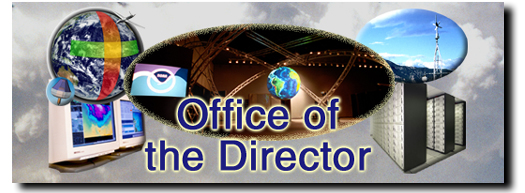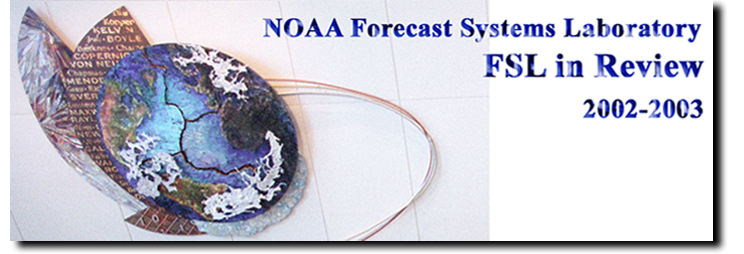|
|

Cover/Title Page
|
|

(303-497-6378)
Web Homepage: http://www.fsl.noaa.gov
Dr. Russell B. Chadwick, Chief Engineer, 303-497-6318
(The above roster, current when document is published, includes
Address: NOAA Forecast Systems Laboratory – Mail Code: FSL
Message from the Acting DirectorFSL strives for excellence in four major areas: 1) bringing new atmospheric observing systems to maturity, 2) developing and improving regional mesoscale models for detailed weather predictions, 3) investigating parallel computer architectures as a vehicle for handling the huge computational demands of environmental models, and 4) developing environmental information systems for a variety of customers, within NOAA and outside. In the past year, FSL continued to gather atmospheric observations from disparate sources in the service of local forecasting and regional modeling. For example, the number of Cooperative Agency Profilers, most of them sampling the boundary layer, has grown to over 60. The number of ground-based GPS sites estimating total column water vapor now exceeds 200. More than 5,000 new surface mesonet observations have been added to the FSL hourly collection. After performing quality control checks, FSL forwards all these data to the National Centers for Environmental Prediction (NCEP) for use in operational models. FSL is developing plans for a global observing system with major in situ components that can settle the controversy about long-term tropospheric warming, monitor natural and anthropogenic atmospheric constituents, and sample the ocean depths. This system would meet requirements for climate monitoring and prediction and also provide much needed calibration of satellite observations in remote locations. The first phase of this program, called "Pacific Plus," would employ a combination of unpiloted aircraft, altitude-controlled balloons, and ocean buoys to sound the atmosphere and water across the length and breadth of the Pacific. Gauging the contributions of various observing systems to forecast accuracy is an important activity. FSL recently completed the modeling and computing infrastructure for performing such impact tests. Because commercial airlines, which supply nearly 100,000 temperature and wind reports per day, are financially strapped, and the continuity of the NOAA Profiling Network is threatened, FSL conducted special impact tests, demonstrating that aircraft and profilers each contributes substantially to forecast accuracy and that these data are highly complementary. Several FSL accomplishments in modeling are noteworthy. Three-dimensional variational analysis became operational in the 20-km version of the Rapid Update Cycle in May 2003. This opens the door to assimilation of many new sources of observations that were previously difficult to accommodate. A Developmental Test Center is being established in Boulder. FSL, NCAR, and NCEP will contribute staff and share computing resources. The initial focus of the Test Center will be on the development of the Weather Research and Forecasting Model, destined to become both an operational model and a research vehicle for the larger modeling community. The Federal Highway Administration supported a collaborative effort between FSL and NCAR to field test a model-based system for snow plow operators that helps them decide when to plow and what chemicals to spread on the road surface. This Maintenance and Decision Support System was successfully tested in Iowa in February and March 2003. In November 2002, FSL accepted a major upgrade to its high-performance computing system,comprising 768 nodes with dual Intel Pentium processors rated at 2.2 Ghz. Also during that month, it was ranked #8 on the Top500 List of the World’s Fastest Computers, and now serves more than two dozen external users representing most of the line offices within NOAA. Capitalizing on major development work at FSL, the National Weather Service began installing two Linux-based workstations at each of its Weather Forecast Offices around the country in January 2002. Eventually these workstations will replace the Hewlett-Packard hardware which inaugurated the Advanced Weather Interactive Processing System (AWIPS) era. The highly robust Linux was developed in an open-source environment and runs on nonproprietary hardware. FSL developed the FX-Net workstation as a low-cost alternative to AWIPS workstations. FX-Net can deliver fairly large datasets primarily because of wavelet compression techniques developed in-house. FX-Net has become the workstation of choice of the National Interagency Fire Center in Boise, Idaho, and at 11 Geographic Area Coordination Centers throughout the country. Meteorologists used FX-Net close to home last summer in fighting Colorado wildfires during an unprecedented drought. NOAA Science On a Sphere (SOS)TM received major exposure during the past year. SOS is a powerful educational tool for projecting geophysical, other planetary, solar, or lunar data onto a sphere. The current prototypes are 5 – 6 feet in diameter. First field tested with hundreds of students and their parents at the Broomfield Heights Middle School last summer, SOS has since been an attraction at the annual meeting of the American Meteorological Society in Long Beach, California, the NOAA Science Center in Silver Spring, Maryland, and, most recently, at the National Cable and Telecommunication Association meeting in Chicago, Illinois. For more information on the above items and many more, I hope you will browse through the following pages. We are eager to share with you our contributions toward NOAA research and technology transfer.


NOAA Science On a SphereTM ProjectDavid Himes, Senior Software Engineer/Team Leader(303-497-5447)
Web Homepage: http://www.fsl.noaa.gov/sos
Objectives


and Broomfield, CO (bottom), learning about Science On a Sphere TM. (NOAA Photos by Will von Dauster, FSL.) Nearly any global data can be displayed on Science On a SphereTM, including the weather, climate, geology, images of solar system bodies, or any type of geographical information that covers a large portion of a planet’s surface. NOAA’s mission to understand and predict changes in the Earth’s environment can derive special benefit from the ability to present its data with a geometry that corresponds to that chosen by nature. In many ways, Science On a SphereTM provides an ideal way to educate the public on many important issues, both environmental and economic, that face NOAA, the United States, and the entire world. AccomplishmentsThe initial Phase 0 prototype was developed in the summer and fall of 2001, using an Apple G4 with four video cards, low-end video projectors, and an acrylic sphere. The system had limitations in terms of resolution (400 x 400 pixel imagery) and a low video frame rate, along with deficiencies related to mapping and synchronization of the images on the sphere. However, even with these limitations, the visualizations and overall concept convinced other NOAA organizations to invest in the project. The Office of Oceanic and Atmospheric Research (OAR); National Weather Service (NWS); National Environmental Satellite, Data, and Information Service (NESDIS); and National Polar Orbiter Environmental Satellite System (NPOESS) provided resources to support the next development stage of Science On a SphereTM. NESDIS gave additional help and played an important role by providing a freestanding suspension structure for the sphere, significant support for dataset creation, and indispensable aid in planning and logistics for conferences and remote events. The goals during Phase 1 development were to improve the system by 1) creating additional media sets to display on the sphere; 2) increasing the pixel resolution used by the display system; 3) improving the focus, convergence, and overall quality of the projected imagery; 4) creating a user interface to control the system; and 5) developing more portable and scalable construction techniques for the sphere itself. All of these goals were achieved to a large extent by December 2002. Phase 1 development culminated in a series of presentations and remote events, starting with a week-long educational workshop at Broomfield Heights Middle School (near Boulder) in October 2002 to test the idea: "Can Science On a SphereTM be used as a teaching tool?" The system was set up in a science classroom at the school, and for one week, nearly 500 students (some future scientists, no doubt) were led through exercises in atmospheric science, geography, and other earth science disciplines. The reactions from the students during the teaching exercises were fascinating to observe. They voiced their surprise to see the Earth and other planets at this scale and were very responsive in the classroom exercises. Some students were so influenced by the presentations and lessons that they were still discussing science at lunchtime in the cafeteria, a rare event according to one teacher. Parents attending parent/teacher conferences saw the sphere in the evening as enthusiastic students showed them what they were learning in science class. In December 2002, Science On a SphereTM was at the NOAA Science Center in Silver Spring, Maryland, for presentations to NOAA staff and management. Various NOAA groups participating in the program were excited with the prospect of displaying new NOAA data from their own group on the sphere. Science On a SphereTM was exhibited at the Annual Meeting of the American Meteorological Society in Long Beach, California, where FSL hosted nearly 2,000 participants from the general public and the scientific community during the week-long conference. Overall comments and audience reactions were very positive, with the more common response that this is a dramatic way of looking at the geographic and atmospheric processes of our planet and conveying that information to the viewer. Most recently, Science On a SphereTM was shown at the Department of Commerce’s Hoover Building in Washington, D.C., (Figure 3) as part of the national program, "Excellence in Science, Technology, and Mathematics Education Week." 

(NOAA Photos by Will von Dauster, FSL.) Projections
The continued success of NOAA Science On a SphereTM is dependent on the support of NOAA and other government organizations, industry, and the private sector. Early and future development of the system is also supported by a very dedicated, capable team at FSL under the leadership of Sandy MacDonald.
|
|

